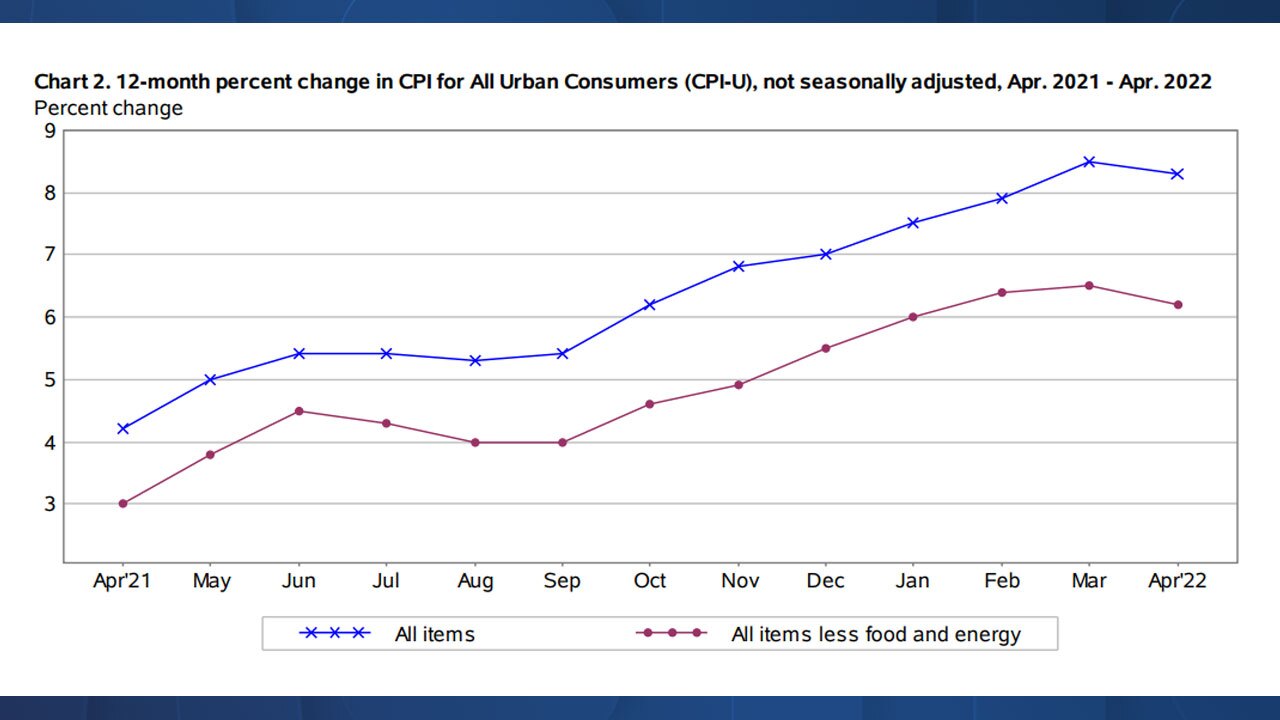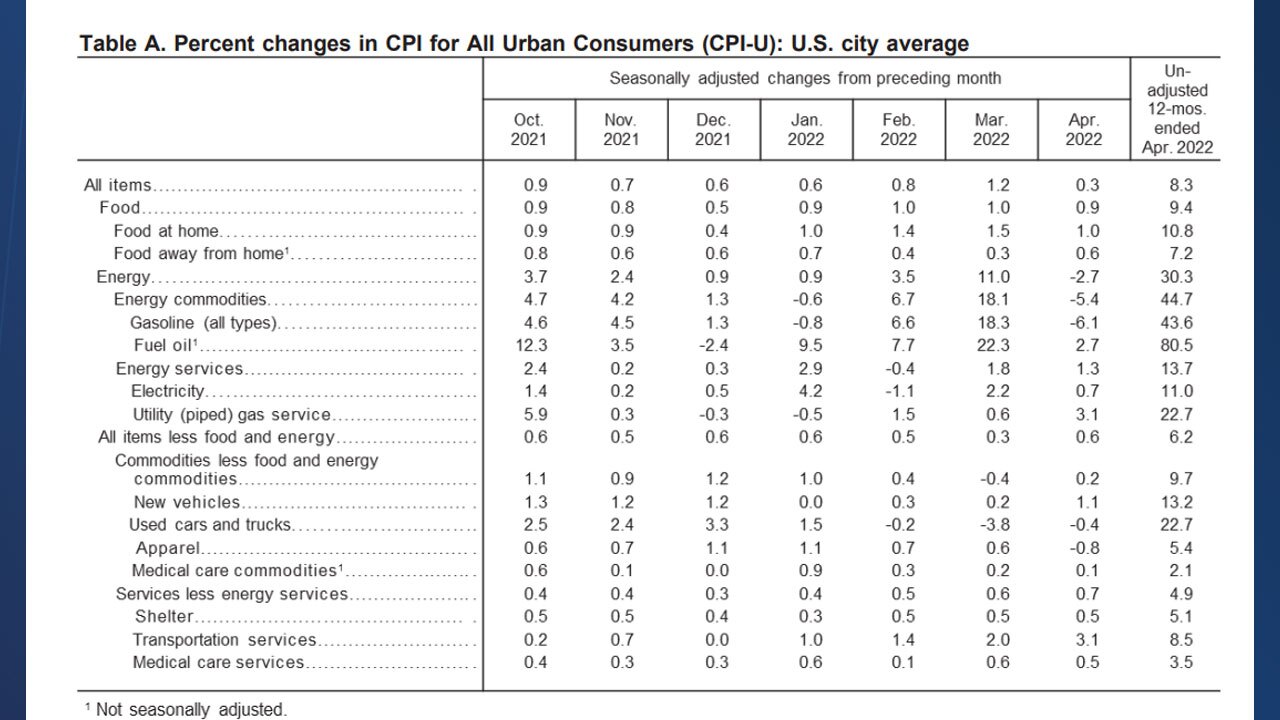TAMPA, Fla. — Wednesday's news of the Consumer Price Index rising again in April quantified what everyone has seen for months, almost everything we buy from food to gas to airfares continues to surge to levels not seen in decades.
ABCActionNews.com breaks down the numbers in the CPI report and how each industry fared in this in-depth report.
What is the CPI?
According to the U.S. Bureau of Labor Statistics, the Consumer Price Index (CPI) is a measure of the average change over time in the prices paid by urban consumers for a market basket of consumer goods and services, also referred to as inflation. The CPI is available for major groups of consumer expenditures including: food and beverages, housing, apparel, transportation, medical care, recreation, education and communication, and other goods and services. The CPI includes user fees (water and sewer) and sales/excise taxes paid by the consumer. The data is collected in 75 urban areas around the country and from 23,000 retail and service establishments along with rent data from 50,000 landlords/tenants.
What is Core CPI?
Because gas and food prices have a tendency to be much more volatile (more on that later), core inflation, or core CPI, is the change in prices minus the changes in prices in the food and energy sectors.
How is the CPI right now in the U.S.?
There's no way to sugarcoat the numbers, inflation is high in the United States almost across the board. Overall, the CPI for April increased 0.3%t on a seasonally adjusted basis after rising 1.2% in March. Over the last year, inflation for all items stood at 8.3%, non-seasonally adjusted. The year-over-year number (8.3%) is what is most focused on by investors, politicians, and journalists.
What about the Core CPI?
The index for all items minus food and energy rose 0.6% in April, which was double the jump in April. According to the Bureau of Labor Statistics, prices rose for shelter, airline fares, new vehicles, medical care, recreation, and household furnishings all rose in April. The indexes for clothing, communication, and used cars/trucks were the only areas to show a decline over the last month. The jump in Core CPI may be just as worrying for investors as it shows the jump in prices isn't primarily being driven by food and gas and instead is spreading across the entire economy. Core CPI approached levels last seen in January last month which can be seen in the following chart.

RECOMMENDED: President Biden calls on Congress to pass his plan to battle inflation
What about specific sectors, how are prices hitting each one?
Good question, here's how prices changed in the key sectors overall.
- Food - Up 0.9%
- Energy - Down 2.7%
- All items - Up 0.3%
- All items minus food/energy - 0.6%

Wait, how could energy prices go down while gasoline prices remain so high?
In April, overall prices in the energy sector did drop in some areas. However, much of this is due to the prices jumping so high in February and March. For example, gasoline (all types) rose 6.6% in February and then another 18.3% in March. Then in April, prices dropped 6.1% for gasoline. However, combined with the previous two months, gas prices are still significantly above where they were in January. Any slight gains for customers with prices may be wiped out in April as gasoline prices have started rising as the busy Memorial Day holiday travel season nears. Overall, gas prices have risen 43.6% in the last year with other motor fuels jumping 64.2% year-over-year in April.
What about food?
If you've been to Publix, Winn-Dixie, or your grocery store of choice, the following won't come as a surprise, but prices for food overall have risen 9.4% year-over-year as of April. But the breakdown of food prices also showed a divide between the price of food for home vs. food away from home. For food at home, the BLS reported prices have risen 10.8% in the last year with each of the last four months showing a growth of at least 1%. At the same time, prices for food away from home have risen 7.2% in the last year, with no month dating back to October 2021 showing an increase of at least 1%.
How do the food prices break down?
April marked the 17th consecutive monthly increase in the food index and the food at home index's 10.8 price jump is the largest year-over-year increase since November 1980. In April, five of the six major grocery store food group indexes increased month-over-month including dairy products (up 2.5%, the largest increase since July 2007), nonalcoholic beverages (up 2%), and the index for meats/poultry/fish/eggs rose 1.4% with eggs driving much of that increase by jumping 10.3% in April. The only food indices showing price declines were for fruits and vegetables, which dropped 0.3%.
Breaking down the food away from home numbers, the slower rise in prices was driven by the index for food at employee sites and schools. That index dropped 30 percent which the BLS attributed to widespread free lunch programs.
What about other industries besides energy and food?
While food and energy are the most volatile, the news isn't much better in other industries. Here's a breakdown of how some industries performed in April.
- Rent index — up 0.5%
- Lodging away from home index — up 1.7%
- Airline fares — up 18.6% (largest one month increase since the CPI for that industry started being tracked in 1963)
- New vehicles — up 1.1%
- Medical care — up 0.4%
- Recreation index — up 0.4%
- Motor vehicle insurance — up 0.8%
Is inflation this high permanent?
While no one can accurately predict the future, economists say inflation won't remain this high indefinitely. The question is when will it peak. Some believe it may have peaked in March with many industries showing record price increases. The U.S. Federal Reserve, which has the responsibility of controlling inflation, recently increased interest rates by 0.5 basis points and is likely to do so again at the next meeting. Whether that will serve as enough of a catalyst to tame inflation remains to be seen. It may help cool off the housing industry as mortgage rates have been increasing, rising to more than 5.2%. The rates are now at their highest levels since 2009 and will likely rise again.
Still, complicating the matters for the Federal Reserve are supply chain issues that don't show signs of slowing down. All of it could make the 2022 summer one of the toughest on consumers in a long time.


